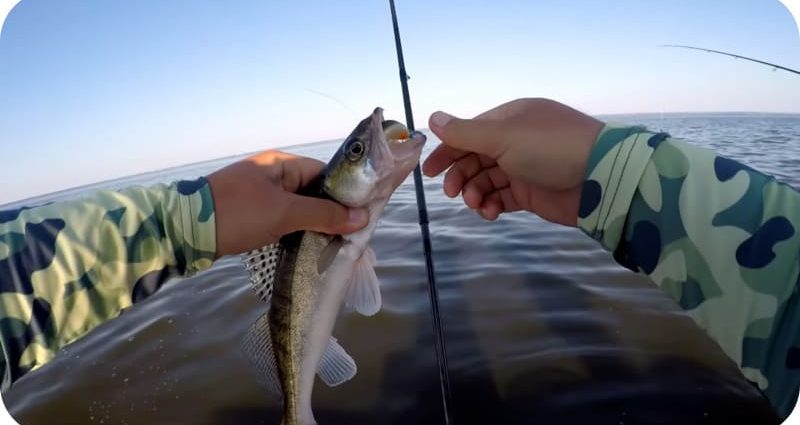Contents
Pike perch is a rather interesting fish, characterized by a large set of useful properties. True, there are some dangers to human health. It has its own characteristics both in habits and in the structure of the body. For some housewives, zander fish is difficult to clean. In this article, we will analyze in detail what kind of fish pike perch is, and also consider where pike perch lives, what is useful, how to quickly and efficiently get rid of scales.
Appearance and features
Pike perch is a ray-finned fish with powerful teeth resembling fangs. Females also have them, but smaller ones. This is the main difference between the sexes.
Another interesting feature of the fish is the lateral line. This is a kind of sensory organ that helps the fanged determine the direction of the flow of water and its strength.
In fact, five species are understood under the name pike perch, but the common one is the most common. It lives in Europe, Asia, and is also found in freshwater areas of the Azov, Black, Baltic and Aral Seas.
What does pike perch look like
The predator is able to grow to an impressive size. Often come across fish up to 1 m and weighing up to 15 kg. But mostly medium-sized predators are caught.
On the back are two long fins, almost in contact with each other. The body itself is elongated and laterally compressed. The color is greenish-gray, and the belly is white. Black transverse stripes are visible on the sides. The mouth looks quite large and strewn with narrow rows. A special difference is the protruding fangs.
Interesting facts about zander
- Pike perch is one of the few modern inhabitants that has existed for many millions of years. Scientists note that it appeared about 25 million years ago in Siberia. At the same time, the last 5 million do not change their appearance.
- Today there are five types of pike perch. Three of them live in Russia:
- common zander;
- Bersh (Volga);
- Sea pike perch;
- Canadian;
- Lightfeather.
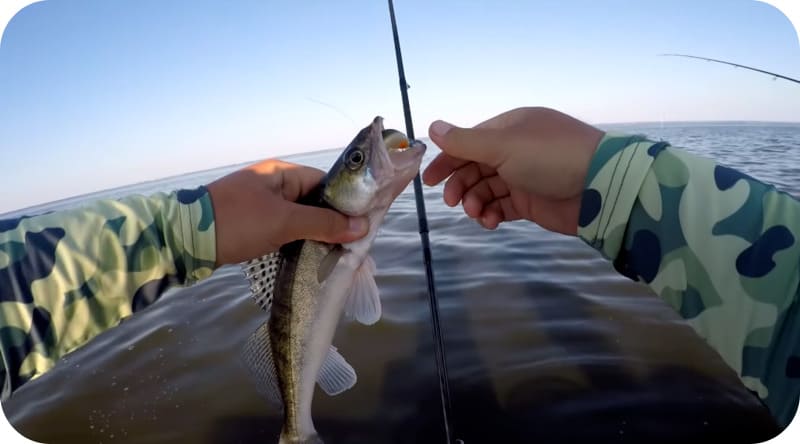
Volzhsky (river pike perch) differs from its fellow (ordinary) in the absence of fangs and a small body size. The last two species are found in North America.
- The predator has good protective properties. The fins act as sharp spikes, and the protruding fangs will completely discourage other predators from attacking a serious opponent. Perhaps that is why he has no natural enemies, with the exception of man.
- Cannibalism among zander is common. In general, the fish is quite gluttonous and constantly feels hungry. Fry already in the first weeks of their lives begin to actively attack small prey. For this reason, the predator is growing at a rapid pace. By the age of five, he can reach a weight of three kilograms.
- Pike perch lives only in flowing water areas. The main condition is clean water. It is almost impossible to meet him in a muddy and muddy reservoir.
Reproduction and life expectancy
Pike perch spawns in the spring, when the water warms up to 12 degrees. Although it can migrate over long distances, it breeds in favorite places, usually at a depth of no more than 7 m. Sometimes even in shallow water. The rest of the time it prefers to be at great depths.
During the spawning period, the fish gather in small flocks. In each of these, both males and females are necessarily present. The latter prepare a place for eggs, clearing it with a tail and making a hole 60 * 10 cm in size (where 60 is long and 10 is deep). Caviar throwing begins in the morning in a vertical position (head down). But the most interesting thing is how many spawns one fish.
The female is able to lay about 1 million eggs. They are yellow in color and 1 mm in size.
The process of fertilization itself occurs as follows, the female spawns, and the largest male pours milk over them. This is not the end of his duties. Then he proceeds to protect future “babies”. True, there are cases when this share passes to the second male (in size). When the young appear, the male leaves them.
10 days after fertilization, fry appear, but they still cannot feed on their own. After a few days, they can be considered full-fledged predators. True, at first they feed on plankton.
Growth rates depend on habitat and food availability. Upon reaching 3 – 4 years, females begin the first reproduction. Pike perch can live up to 17 years. He is one of the few fish considered long-lived.
How is pike perch different from other fish
Initially, it is worth figuring out which family of fish the zander belongs to. After all, even here it has many differences. Predatory fish belongs to perch, but there is practically no external resemblance to perch. It surpasses it in size, is distinguished by the presence of fangs, a more pointed and long nose.
Even brothers have significant differences. So, bersh is much smaller than ordinary pike perch. The maximum weight does not exceed 1,4 kg, and the length is 45 cm. There are scales on the gills, but the zander does not have it.
There are also differences in the teeth. The bersh has no fangs and the teeth themselves are smaller. The eyes are larger, the head is wider, but shorter. But the color is practically the same.
Where does he live in Russia
The following seas are considered the primary habitat of the predator:
- Azov;
- Black;
- Aral;
- Caspian.
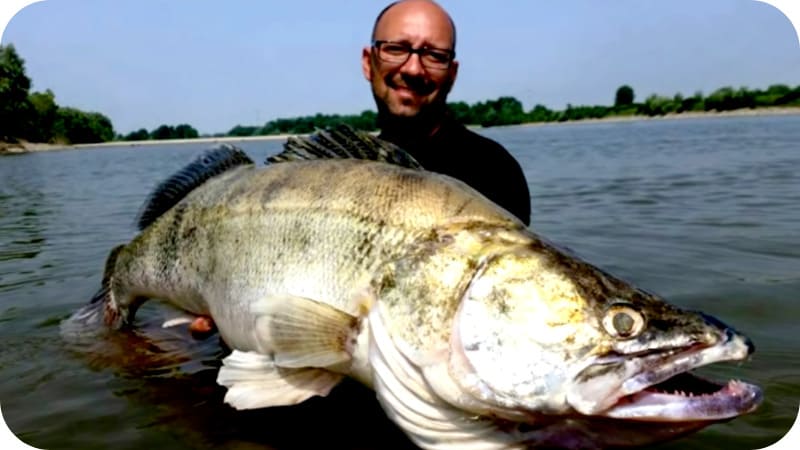
You can also meet him in Siberia and the North of Russia. These are mainly rivers and lakes (Ladoga, Chudskoye and others). Many fishermen are concerned about the question, where is pike perch found in large numbers? A favorite habitat is the Azov and Caspian Seas, or rather in their lower reaches. Hence the uncertainty “Pike perch is a sea or river fish?”. The fanged one is not afraid of salt water, but still tries to stay close to fresh water and is considered a freshwater inhabitant.
Useful properties of fish
In addition to the fact that pike perch is distinguished by delicious tender meat, it is also notable for a rich set of useful properties. Unlike carp, zander meat is lean, and many nutritionists advise those who want to lose weight to eat it. In addition, the predator is less bony, which simplifies the cooking process.
Fish meat is also useful for children. As pediatricians assure, a child can be fed with pike perch for up to a year. Meat contains a lot of healthy protein, amino acids (20 items), a rich set of minerals and vitamins.
Eating fish meat has a positive effect on the cardiovascular, endocrine, digestive, and musculoskeletal systems. In addition, mental and physical performance improves.
Dangerous properties of fish
Despite the benefits of fish, it should be eaten with caution. Otherwise, you can harm the body. A lot of it has to do with proper preparation. For example, dried pike perch is not subjected to sufficient heat treatment, which increases the risk of infection with parasites (helminths). In addition, smoked fish has a bad effect on the digestive tract. It is also worth abandoning pike perch for people with individual intolerance to seafood.
According to research by virologists, pike perch is prone to peptic ulcers. Experimental animals were infected from fish, which led to the appearance of tumors in the gastrointestinal tract. Outwardly sick fish can be distinguished. Light formations up to 10 cm in diameter appear on her body.
Pike perch lifestyle
Pike perch is a schooling fish, but up to a certain point. Large fish prefer to live apart. Predominantly, the habitat is great depths with depressions, pits, snags, etc.
Based on the size of the mouth, you can understand what the zander eats. First of all, these are narrow-bodied fish. Also does not refuse frogs, worms, crustaceans.
During feeding, it can go to shallow water. Most often for minnows. It is most active during the pre-spawning period (spring) and autumn.
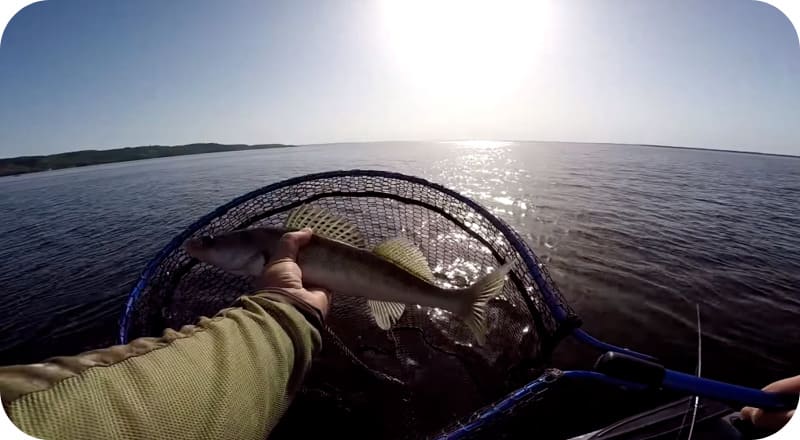
He does not like high temperatures and therefore it is difficult to find him on a summer day. It comes out of its hole only at nightfall. True, immediately after spawning it is highly active, but not for long (a couple of weeks). In winter, it may even hibernate.
Fishing value
Pike perch is considered a commercial fish due to its beneficial nutritional properties. Dietary fish meat has a positive effect on human health. In addition, pike perch is an object of sports and amateur fishing.
Ways to catch zander
Fish are caught in a variety of ways. The most popular are:
- Jig fishing using a retractable leash.
- Fishing for baubles and other artificial lures (wobblers).
- With the help of bottom gear.
You can also fish from a boat. Basically it’s trolling. This method makes it possible to catch large areas, which increases the efficiency of fishing. You can find promising places with the help of an echo sounder.
Wobblers are the best bait. Manufacturers make models, including for pike perch. You can find more details in the description of online stores.
How to clean and cut
The main problem for housewives is cleaning fish from scales. She is quite tough and sometimes difficult to handle, but there are a few life hacks:
- Metal grater. The side with sharp protruding teeth easily separates the scales from the fish;
- Tablespoon. The spoon is taken with the bulge up and the scales are hooked by the edge. With smooth movements from tail to head, we begin cleaning;
- Salt. The fish is completely wrapped in salt and infused for 10-15 minutes. After that, the scales are easily removed with a stocking along with the skin.
In fact, there are many cleaning methods. Easily scales give in to a high-pressure water jet. Some craftsmen make special tools for cleaning. It is better to clean the prey right on the shore with a fishing knife so as not to litter at home.
Well, if you decide to deal with it at home, then it is better to do it in water or inside a plastic bag. So the scales will scatter less.
How to gut pike perch
After you are done with the cleaning, you can start cutting the pike perch. To do this, take a kitchen knife in one hand, and place the fish belly up with the other hand. Make a cut in the abdomen from the tail to the head.
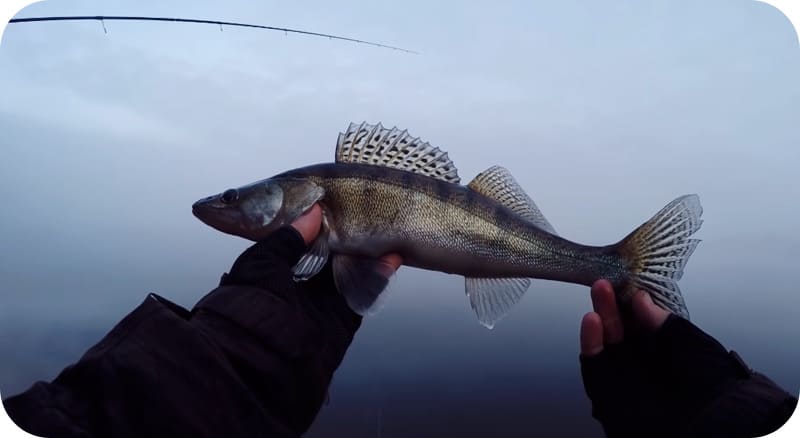
Then take out the insides, and rinse the cavity thoroughly. Do not pierce the gallbladder with the knife.
Fish cutting
Most often, pike perch is cut into fillets. In this case, the fish does not have to be scaled, but the offal must be removed. For cutting, you will need a fillet knife and a cutting board. Action algorithm:
- Along the dorsal part we make a deep incision to the ridge.
- On the belly in the head part we make another incision. In the place of the cut, we hook the meat with a special knife and make a U-turn parallel to the ridge.
- We cut the meat along the ridge, tucking the knife at an angle of 35 degrees.
- Then, in the same way, remove the meat from the bones of the fish.
- Putting the knife flat, remove the meat from the scales.
By the same principle, we deal with the second side of production. Now you can cook the meat.
Ways to cook pike perch
You can cook many different dishes from pike perch meat. Starting from simple frying in a pan and ending with a layer cake. Pike perch dishes:
- Pike perch in Polish;
- Uha po-Finnish;
- Jellied pike perch;
- Fried with ginger and cinnamon;
- Cutlets with cheese;
- Baked with vegetables;
- Heh from pike perch;
- In cream;
- With sour cream in a slow cooker;
- Layered fish pie.
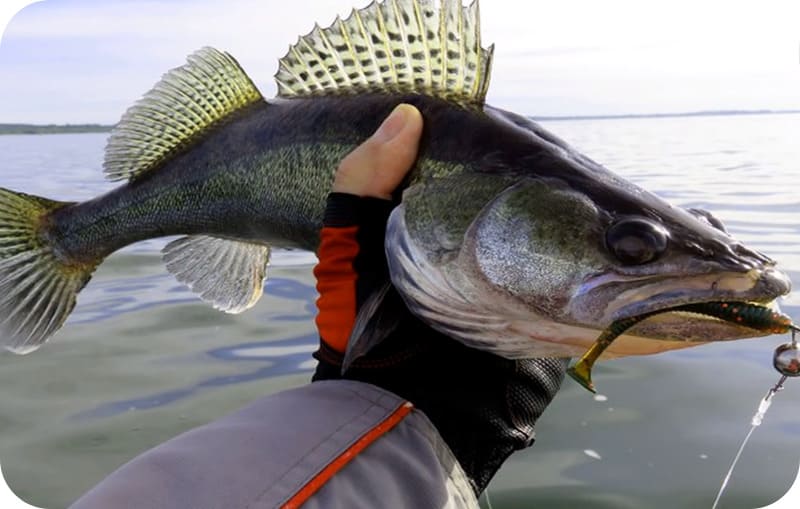
The most interesting is the last dish. Layer cake recipe:
- Fillet 200 gr;
- Dill 50 gr;
- Fresh parsley 50 gr;
- Green onions 100 gr;
- Potato 3 pcs;
- Ready puff pastry half a kilo;
- Salt pepper;
- Olive oil 2 tbsp;
- Sunflower oil 1 tbsp;
- Chicken egg 1 pieces.
Preparation
Rinse the fish thoroughly and dry with a paper towel. Cut into small cubes, chop the greens. Cut potatoes into thin circles. We roll out the dough, spread the fish seasoned with spices and herbs.
Drizzle with olive oil and spread potatoes. We connect the ends of the dough and fasten at the top, leaving a few holes for the steam to escape.
Grease a baking sheet with sunflower oil. Then lay out the cake. We cover the cake with yolk. We send it to the oven for 30-40 minutes at 180 degrees.
If the fish is purchased on the market, then its freshness can be determined by its color. Yellowish meat indicates that the fish has been thawed more than once. The meat of fresh pike perch has a bright red color.










